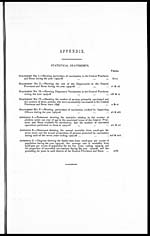Medicine - Vaccination > 1868-1929 - Report on the vaccine operations in the Central Provinces > Vaccine operations Central Provinces 1900-1911 > 1905-1906 - Notes on vaccination in the Central Provinces for the season 1905-06
(247) Page 4
(248) next ›››
Half title page
Download files
Individual page:
Thumbnail gallery: Grid view | List view

4
The use of glycerinated calf lymph has steadily increased, but the percentage
of success was 93.14 against 96.14 in the previous year.
18. In Mandla and Chanda lymph was not manufactured at head-quarters
owing to difficulty in getting a sufficient number of calves. The supply of lymph
was therefore kept up by vaccinators by vaccinating calves in their circles. In
Drug also glycerinated lymph was prepared in the interior of the district. In the
rest of the districts, excluding the districts in Berar, glycerinated calf lymph
was prepared at head-quarters. In Hoshangabad, Nimar, Raipur and Bilaspur
it was prepared in the interior of the district as also at head-quarters as
sometimes it was not possible to supply it to Vaccinators in sufficient quantity
for want of calves. In Berar glycerinated calf lymph, manufactured at the
Amraoti Paste Depôt, is supplied to all Vaccinators in the Province. But in the
months of April and May as lanolinated lymph was found ineffective, owing to the
heat, cow lymph was prepared and used in the Yeotmal District, while in the
Buldana District lymph was obtained from Betul during the months of June and
July. In the remaining months of the year the lymph prepared at the Amraoti
Depôt was used.
Vaccination in Municipali-
ties.
(Appendix A.)
19. During the year under report the Sambalpur Municipality was transfer-
red to Bengal, and with the exception of Pulgaon in the
Wardha District and Dhamtari in the Raipur District the
Vaccination Act was not extended to any additional town.
Of 23,523 children under one year available for vaccination 22,802, or 96.93 per
cent., were successfully vaccinated—a satisfactory result compared with 86.16 per
cent. in the previous year. In 19 Municipalities more children than are shown as
available were successfully vaccinated and the cause of this excess was the same
as explained in paragraph 8 ante.
Mortality from small-pox as
compared with proportion of
persons protected by vaccina-
tion (Appendix B).
20. The mortality from small-pox in the Central Provinces, as in Berar,
was higher than in any of the 10 previous years. Exclud-
ing Feudatory States the proportion per 1,000 of popula-
tion protected by vaccination was 43.42 against 41.20 in
the previous year. The usual diagram is appended.
Cause of delay in submitting
the Notes.
21. The submission of these notes which were due in the Secretariat Press
on the 20th May was unavoidably delayed owing to non-
receipt of the particulars referring to the States recently
transferred to the Central Provinces from Bengal. After some correspondence
with the Political Agent, I find that in these States vaccination was either
performed from outside, or that little or no attention was paid to it. The
statistics are therefore not available and have been omitted from the statements
appended to these notes. The Political Agent assures me that they will be
forthcoming next year, as, since their transfer to the Central Provinces, the
States have taken over vaccination work and will be held responsible for the statistics
as well as for the work of vaccination. The delay is also due to difficulty in getting
accurate statistics from the districts affected by the recent reconstitution of
districts in Berar and Chhattisgarh.
General remarks.
22. It will be observed that vaccination operations during the year under
report have been generally satisfactory. There is, how-
ever, still room for improvement and I expect much in
the ensuing year.
Set display mode to: Large image | Zoom image | Transcription
Images and transcriptions on this page, including medium image downloads, may be used under the Creative Commons Attribution 4.0 International Licence unless otherwise stated. ![]()
| Permanent URL | https://digital.nls.uk/91521008 |
|---|
| Attribution and copyright: |
|
|---|



